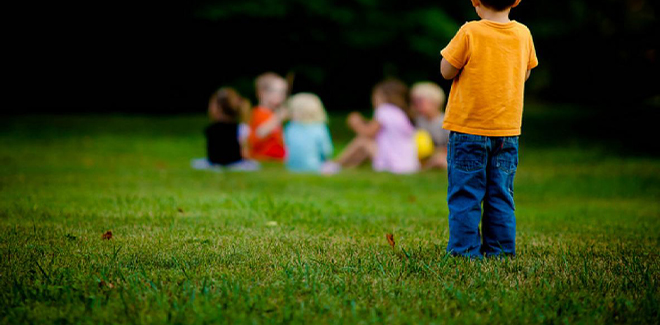Social isolation in children is one of the important social concerns that has attracted increasing attention in recent years. It refers to a condition in which a child experiences limited or no social interaction with peers or the community.
While some degree of loneliness can be healthy, chronic or severe social isolation can have profound and lasting consequences on a child’s emotional, psychological, and even physical development. The rise of technology, changes in family structure and the impact of global events, such as the Covid-19 pandemic, have all contributed to the increased risks of Social isolation in children.
This phenomenon can appear in different ways, from the rejection of the child by his peers at school to more severe cases that include complete withdrawal from social activities. The impact of social isolation on children’s mental health cannot be ignored.
Loneliness, depression in children, child anxiety and low self-esteem are common emotional reactions. Additionally, it can hinder the development of basic social skills and make it challenging for these children to build healthy relationships in the future.
Therefore, it is critical for parents, educators, and society at large to address and mitigate the effects of social isolation in children to ensure their long-term well-being and success.

What is social isolation in children?
Social isolation in children refers to a situation in which a child experiences limited social interaction with peers, family, or the wider community. This can manifest in many ways, from feeling rejected or left out by peers at school to more extreme cases where the child may withdraw from social activities altogether.
Social isolation often leads to a lack of meaningful social relationships and connections, which can have destructive effects on a child’s emotional, psychological, and social development. Many factors can contribute to social isolation in children, including bullying, a shy child, lack of social skills, family issues, cultural or language barriers, and environmental factors.
The degree of social isolation in children can vary, with some children experiencing occasional bouts of loneliness or isolation, while others may endure severe isolation, which can have a lasting impact on their overall well-being. be have
It is important to note that social isolation in children is not a normal or healthy developmental state. Appropriate social interactions and relationships are vital for a child’s emotional development and cognitive skills, and the lack of such interactions can lead to issues such as loneliness, depression, anxiety, and delays in the development of critical social skills.
Addressing and reducing social isolation in children is essential to ensure their emotional and psychological well-being, as well as their ability to form healthy relationships and thrive in their future social environments.
What are the signs of isolation in children?
Social isolation in children can be manifested through various signs and behaviors. It is important for parents, caregivers, and educators to pay attention to these indicators because they may indicate that a child is experiencing social isolation.Some common symptoms of social isolation in children include:
- Withdrawal: Isolated children may become increasingly withdrawn or introverted. They may spend a lot of time alone and avoid social interactions or group activities they once enjoyed.
- Loneliness: A child experiencing social isolation often feels lonely and may often talk about not having friends or feeling left out.
- Reduced academic performance: Social isolation in children can affect their academic performance. They may have trouble concentrating, being motivated, and participating in schoolwork.
- Changes in sleep patterns: Isolated children may experience disruptions in their sleep patterns, including trouble falling asleep, sleepy awakenings during the night, or excessive sleep.
- Emotional changes: Children who are socially isolated can show emotional changes such as increased consumption, sadness and mood swings. They may also become more mobile or have outbursts of anger.
- Physical symptoms: Social isolation can sometimes lead to symptoms such as headaches, stomachaches, and weakened immune systems due to stress.
- Reduced self-esteem: isolated children may have low and negative self-esteem. They may feel loved, unimportant, or unappreciated.
- Lack of interest in hobbies and activities: Children who are socially isolated may lose interest in activities and hobbies they once enjoyed. They may lack motivation to pursue their interests.
- Online or media addiction: In the digital age, some isolated children may turn to excessive use of social media or video games as a way to connect with others or escape their feelings of isolation.
- Difficulty making friends: Isolated children may have difficulty making and maintaining friendships. They may exhibit poor social skills and find it challenging to interact with their peers.
It is important to remember that these symptoms can vary from child to child and not all isolated children show all of them. If you notice these symptoms in a child, it is very important to support them and, if necessary, seek professional help to address the root causes of their withdrawal and help them develop social skills and communication.
Social isolation on different age groups
The effects of social isolation on children can be different depending on their age group and stage of development. Here are some of the key effects of social isolation on different age groups of children:
1- Preschool children (2 to 5 years old):
Speech and language delay: Social isolation can hinder language development in preschool children, as they may have limited opportunities for social interaction and communication with peers.
Difficulty with emotional regulation: Isolated preschoolers may have trouble regulating their emotions, leading to frequent tantrums and emotional outbursts.
Delayed social skills: Lack of exposure to social situations may delay the development of essential social skills such as sharing, turn-taking, and cooperation.
2- School-age children (6-12 years old):
Academic Struggles: School-age children who are socially isolated may experience difficulties in school, both academically and behaviorally. It may be difficult for them to concentrate and participate in class activities.
Low self-esteem: Isolation can lead to low self-esteem and lack of self-confidence in school-age children, which can affect their overall well-being and social interactions.
Bullying and peer rejection: Isolated children are often at greater risk of being targeted by bullies, which can exacerbate feelings of isolation and lead to emotional trauma.
3- Teenagers (13 to 18 years old):
Mental health issues: Social isolation during adolescence is strongly associated with an increased risk of mental health problems such as depression, anxiety, and even suicidal thoughts.
Risky behaviors: Isolated adolescents may be more vulnerable to engaging in risky behaviors, such as substance abuse, self-harm, or delinquent activities.
Lack of academic success: Adolescents who experience social isolation may have problems academically and may even drop out of school due to lack of motivation and social support.
4- Youth (19+ years):
Long-term psychological impact: The effects of social isolation in childhood can continue into adulthood and lead to long-term psychological and emotional problems, making it difficult to create and maintain relationships.
Impact on Career and Independence: Young adults who experience social isolation during childhood may find a path in the social and professional environments they foster that prepares them for career and independence.
It is important to know that these effects can be reduced or even prevented through early intervention, social support and treatment. Parents, caregivers, educators, and mental health professionals should be aware of the potential consequences of social isolation and work to provide children with the tools and resources necessary for healthy social development.

What is the long-term effect of isolation on a child’s mental health?
The long-term effects of isolation on a child’s mental health can be profound and lasting. Social isolation in childhood is associated with a range of psychological and emotional issues that can continue into adolescence and adulthood. Some of the long-term effects of isolation on a child’s mental health include:
Increased risk of mental health disorders: Children who experience social isolation are more at risk of developing mental health issues such as depression, anxiety, and social anxiety disorder. These conditions can persist into adulthood and have a significant impact on a person’s overall well-being.
Low self-esteem and self-confidence: Isolation can lead to feelings of inadequacy and low self-esteem. Children who grow up in isolation may struggle with self-esteem and confidence throughout their lives, which can affect their relationships, careers and personal development.
Difficulty forming and maintaining relationships: Long-term isolation can hinder a person’s ability to form and maintain healthy relationships in adulthood. They may find it difficult to trust others, express their feelings, or engage in social interactions, which can lead to greater loneliness and isolation.
High risk of substance abuse: Some people who experience prolonged isolation may turn to substance abuse as a coping mechanism for their emotional distress. This can lead to addiction and related mental health challenges.
Impaired coping skills: Isolated individuals may have underdeveloped coping skills, which makes it difficult for them to manage stress, adversity, and life challenges. This can lead to greater vulnerability to mental health problems.
Increased risk of suicidal thoughts and self-harm: Social isolation is a known risk factor for suicidal thoughts and self-harm behaviors that can persist into adulthood and pose a significant threat to a person’s life.
Effects on physical health: Prolonged isolation can also have physical health consequences, including increased risk of chronic disease and weakened immune systems due to the chronic stress associated with social isolation.
It’s important to note that the effects of isolation can vary from person to person, and not everyone who experiences childhood isolation will experience severe long-term consequences.
Early intervention, social support, therapy and social skills development can help reduce some of these effects. It is important for parents, caregivers, educators, and mental health professionals to be aware of the potential long-term consequences of social isolation and to work to provide appropriate support and resources to children experiencing isolation.

Ways to fight social isolation in children
Fighting social isolation in children is essential to promote their emotional, psychological and social well-being. There are several effective strategies and interventions that can help prevent social isolation in children:
Promote the development of social skills:
Encourage children to develop and practice social skills such as effective communication, active listening, and conflict resolution. These skills can help them build and maintain relationships.
Peer support programs:
Implementation of peer or friend guidance systems in schools and social organizations. Older children or peers can be paired with those at risk of isolation to provide friendship, support and guidance.
Comprehensive activities:
Create extracurricular activities and clubs that cater to different interests, so kids can find peers and engage in shared fun.
Family Engagement:
Encourage parents and caregivers to contribute to their child’s social development by supporting play dates, group activities, and social engagement.
Counseling and mental health services:
Ensuring access to mental health services and counseling for children experiencing social isolation. Professional therapists can help children manage feelings of loneliness and develop coping strategies.
School-based initiatives:
Schools can organize anti-bullying programs, mentoring programs, and social-emotional learning curricula to create a supportive and inclusive environment.
Community participation:
Participate in social events and organizations that promote social interaction, such as sports teams, art classes, or community service projects.
Online and offline inventory:
Encourage a healthy balance between online and offline activities. While technology can provide opportunities for communication, it is important to ensure that children have face-to-face interactions as well.
Parental monitoring of online activity:
Monitor your child’s online development, as cyberbullying and excessive screen time can contribute to social isolation. Teach children how to use technology.
Open communication:
Encourage open and honest communication with children about their feelings and experiences. They know they can talk about the issues they face without judgment.
Celebrate the differences:
Teach children to accept diversity and appreciate the differences of their peers. Create an environment where individuality is valued.
Professional help:
If social isolation becomes severe or is associated with significant psychological problems, seek professional help from a child therapist, counselor, or psychologist.
Positive role models:
Expose children to positive role models who can inspire them and guide them in social skills and emotional development.
It is important to proactively address social isolation and tailor interventions to each child’s specific needs and circumstances. A combination of strategies and ongoing support from parents, educators, and the community can significantly reduce the impact of social isolation and promote healthy social development in children.












